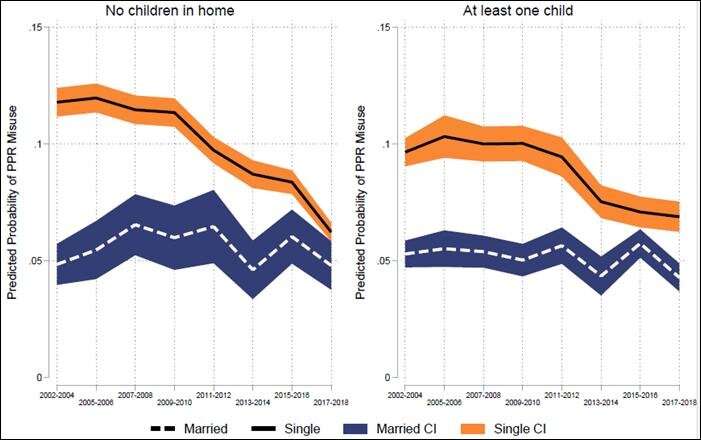
As opioid use disorders and overdoses continue to skyrocket in the United States, a study by researchers from Syracuse University and Pennsylvania State University shows that unmarried young adults who do not have children are mostly likely to misuse opioids.
The growing number of these “disconnected” young adults may also result in continued rises in substance use disorders and overdoses, the researchers say. The study, “Opioid misuse and family structure: Changes and continuities in the role of marriage and children over two decades,” was published recently by Drug and Alcohol Dependence.
The study is also summarized in the Lerner Center for Public Health Promotion research brief “Family Ties Protect against Opioid Misuse among U.S. Young Adults.”
Opioid use disorders affect over 2.1 million people in the United States, and rates of drug overdose have climbed steadily over the past three decades. In their previous studies, this group of researchers found that most people who misuse opioids, including prescription opioids, heroin and fentanyl, started their use during young adulthood.
Using a nationally representative study of U.S. adults ages 18-34 from 2002-18, the researchers examined the links between family structure (marital status and presence of children in the household) and opioid misuse. They found that married young adults have lower probabilities of prescription opioid misuse and heroin use, and that the presence of children in the household is associated with lower probabilities of prescription opioid and heroin use, especially among those who have never been married.
“In the U.S., declining marriage rates have led to increases in adults without a partner or children—a group we refer to as ‘disconnected adults,’ ” said researcher Shannon Monnat from Syracuse University. “These family structure changes have coincided with the dismantling of economic and social institutions that once acted as safety nets, leading to increases in opioid misuse as self-medication for psychological pain, distress, and disconnection from work, family, and social institutions.”
The research team included Monnat, Lerner Chair for Public Health Promotion and an associate professor of sociology at Syracuse University, and Penn State Population Research Institute scholars Alexander Chapman (a Ph.D. student in the sociology department) and Ashton Verdery, an associate professor of sociology and demography.

Here are the key findings from their study:
- Nearly 20% of U.S. adults ages 18-34 misused prescription opioids between 2002 and 2018. About 2% used heroin.
- Married young adults have lower age-adjusted probability of prescription opioid misuse and heroin use.
- The presence of children in the household protects against opioid misuse, especially among single adults.
- Young adults who are not married and do not have children (“disconnected adults”) have the highest age-adjusted probability of opioid misuse.
- Increases in disconnected young adults may result in continued increases in substance use disorders and overdoses.
The researchers say these findings persisted even after accounting for several demographic and socioeconomic characteristics of respondents. Their findings suggest that increases in disconnected adults in the U.S. may result in continued increases in substance use disorders and overdoses.
“Our findings reflect the importance of social connections in preventing substance misuse,” Monnat said. “Policymakers and community leaders can intervene by enacting strategies and advocating for policies that help young adults build social and community connections.”
Who is at Greater Risk of Opioid Misuse?
Nearly 20% of U.S. adults ages 18-34 misused prescription opioids between 2002 and 2018. About 2% used heroin. Prescription opioid misuse increased between 2002 and 2006, leveled off in 2007-2010, and declined from 2011 to 2018. Heroin use increased from 2002 to 2014, but then declined after 2014.
The researchers found that adults with children and who are married were less likely to report prescription opioid misuse and heroin use. Adults who are both single and without children are at greatest risk of opioid misuse. These findings hold even when controlling for factors that might influence marriage, childbearing, and opioid use: educational attainment, employment status, age, race/ethnicity, and metropolitan status.
Source: Read Full Article


